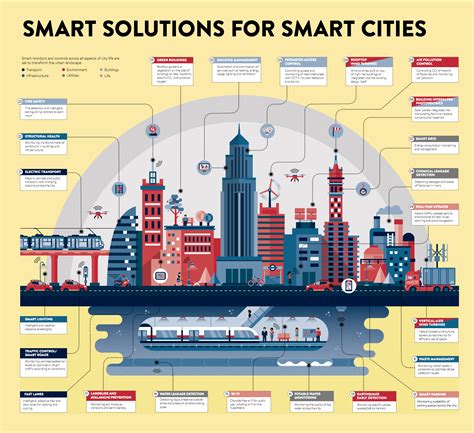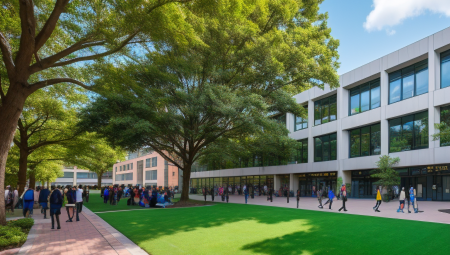In the era of rapid urbanization and technological advancement, the concept of Smart Cities has emerged as a promising solution to the complex challenges faced by urban communities. Smart Cities integrate cutting-edge technology and data-driven solutions to improve the efficiency, sustainability, and livability of cities. Top universities in the United States have been at the forefront of pioneering Smart Cities programs, conducting groundbreaking research and implementing innovative initiatives to design the cities of the future. This blog post will explore the concept of Smart Cities, the role of leading US universities in shaping this field, and how technology is being integrated into urban development to create smarter and more resilient cities. From harnessing data for efficient resource management to enhancing citizen engagement through smart governance, we will delve into the various aspects of Smart Cities and their impact on urban environments. Join us as we embark on a journey to uncover the future of Smart Cities and the pivotal role of education in shaping this transformative landscape.
Table of Contents
Understanding the Concept of Smart Cities
In the modern era, the concept of smart cities has gained significant attention as urban areas continue to grapple with increasing population and limited resources. A smart city is a designation given to a city that incorporates information and communication technologies (ICT) to enhance the quality of life for its residents, improve the efficiency of urban services, and reduce the overall environmental footprint. These cities leverage data and technology to address various urban challenges, such as traffic congestion, energy consumption, and waste management. The core idea behind a smart city is to create a sustainable and efficient urban environment that caters to the needs of its residents while minimizing negative impacts on the environment.
One of the key components of a smart city is the integration of various technologies, including IoT (Internet of Things), sensors, and data analytics, to collect and analyze real-time information. This enables city authorities to make data-driven decisions and optimize the delivery of public services. For example, smart transportation systems can use GPS data to manage traffic flow and reduce congestion, while smart energy management solutions can ensure optimal usage of resources and minimize wastage.
Furthermore, smart cities emphasize the importance of citizen engagement and participation in decision-making processes. Through digital platforms and mobile applications, residents can provide feedback, report issues, and access information about various urban initiatives. This approach fosters a more inclusive and transparent governance model, where the needs and concerns of the community are taken into account when planning and implementing urban projects.
Overall, the concept of smart cities encompasses a holistic approach to urban development, utilizing technology and data to create sustainable, efficient, and livable environments for residents. By understanding and embracing the principles of smart cities, cities can work towards addressing pressing urban challenges and building a better future for their communities.
Top US Universities Leading the Way
In today’s rapidly evolving world, some of the top US universities are at the forefront of driving innovation and progress in various fields. These institutions play a crucial role in shaping the future of education, technology, and research, setting high standards for academic excellence and pushing boundaries in various domains.
With cutting-edge facilities, world-class faculty, and a strong focus on research and development, these universities are continuously pioneering new breakthroughs and setting industry benchmarks. Their commitment to excellence and their relentless pursuit of knowledge have positioned them as global leaders, setting the bar for other institutions worldwide.
Whether it’s in the fields of technology, urban development, energy management, or social services, these top US universities are driving change and leading the way in creating innovative solutions to complex challenges. Their influence extends beyond the campus, with their research and initiatives impacting communities, industries, and policies at a national and global level.
By fostering a culture of collaboration, entrepreneurship, and creativity, these universities are empowering a new generation of leaders, thinkers, and innovators, who are equipped to tackle the complex issues facing our world today. Through their commitment to excellence and their relentless pursuit of knowledge, these top US universities are paving the way for a brighter, more sustainable future.
Integrating Technology and Urban Development
Integrating technology and urban development plays a crucial role in creating sustainable and efficient cities for the future. The use of advanced technologies in areas such as transportation, energy management, and governance can significantly improve the overall quality of life for urban residents.
By incorporating smart technologies into urban planning and development, cities can enhance their infrastructure and services, leading to a more connected and accessible environment for their citizens. This includes the implementation of smart grids for energy distribution, intelligent transportation systems for improved mobility, and digital platforms for e-governance.
Furthermore, the integration of technology in urban development allows for better resource management, environmental sustainability, and overall resilience to external challenges such as climate change and population growth. It enables cities to adapt and respond to the evolving needs of their inhabitants, fostering a more livable and inclusive community for all.
In conclusion, the integration of technology and urban development is essential for creating smart, sustainable, and future-ready cities. By leveraging innovative solutions and embracing digital transformation, cities can address urban challenges and build a more resilient and efficient environment for their citizens.
Innovative Smart Infrastructure Solutions
Smart infrastructure solutions have become essential in today’s rapidly growing urban environments. With the rise of smart cities, the need to develop innovative infrastructure solutions has never been more important. From advanced transportation systems to efficient energy management, smart infrastructure is reshaping the way we live and interact with our urban surroundings.
One of the most groundbreaking innovations in smart infrastructure is the integration of IoT technology. By connecting various components of the urban environment through a network of sensors and devices, cities can gather real-time data to monitor and manage their infrastructure more effectively. This allows for predictive maintenance, waste reduction, and improved resource allocation.
Another key aspect of innovative smart infrastructure solutions is the incorporation of renewable energy sources. By harnessing solar, wind, and other sustainable energy options, cities can reduce their carbon footprint and dependency on traditional energy sources. This not only benefits the environment but also contributes to long-term cost savings and energy efficiency.
Moreover, smart infrastructure solutions also focus on improving the overall connectivity and accessibility of urban areas. This includes the development of high-speed internet networks, smart street lighting, and digital infrastructure for public services. By creating a connected and integrated urban environment, cities can enhance the quality of life for their residents and foster economic growth.
Harnessing Data for Efficient Resource Management
Efficient resource management is crucial for the sustainable development of smart cities. With the rapid urbanization and increasing demands on resources, it has become imperative to find innovative solutions to optimize the use of resources. One way to achieve this is by harnessing data to gain insights into resource consumption patterns and trends.
Smart cities can leverage advanced technologies such as Internet of Things (IoT) sensors, smart meters, and data analytics to monitor and manage resource usage in real-time. By collecting and analyzing data on energy consumption, water usage, waste generation, and other resources, city authorities can make informed decisions to optimize resource allocation and reduce waste.
Furthermore, the integration of data from various sources such as public transport systems, traffic flow, and weather conditions can enable cities to implement dynamic resource management strategies. For instance, predictive analytics can be used to anticipate peak energy demand and adjust supply accordingly, leading to more efficient resource utilization.
In addition to improving the efficiency of resource management, harnessing data can also help cities to enhance their overall sustainability and resilience. By gaining a deeper understanding of resource usage patterns, cities can develop targeted strategies to promote energy conservation, water preservation, and waste reduction, contributing to a more environmentally friendly and cost-effective urban environment.
Improving Urban Mobility with Smart Transportation
With the rapid urbanization of cities around the world, the need for efficient and sustainable transportation systems has become increasingly important. Smart transportation is the integration of technology and urban development to improve overall urban mobility. This includes various modes of transportation such as buses, trains, and even ride-sharing services.
One key aspect of smart transportation is the use of data to optimize traffic flow and reduce congestion. By harnessing data from various sources, such as GPS, traffic cameras, and mobile apps, cities can better understand traffic patterns and make informed decisions to improve urban mobility.
In addition to data utilization, the implementation of infrastructure solutions plays a crucial role in improving urban mobility. This includes the development of dedicated bus lanes, bike-sharing programs, and pedestrian-friendly walkways. These infrastructure solutions help to create a more efficient and accessible transportation network for urban residents.
Furthermore, smart transportation also involves the adoption of sustainable energy management practices. This can include the use of electric buses, charging stations for electric vehicles, and the integration of renewable energy sources into the transportation system. By embracing sustainable energy management, cities can reduce their carbon footprint and contribute to a cleaner environment.
Sustainable Energy Management in Smart Cities
One of the key aspects of a smart city is its ability to manage energy in a sustainable manner. As cities continue to grow and urban populations increase, the demand for energy also rises. It is crucial for smart cities to adopt innovative and efficient energy management solutions to meet these demands while minimizing environmental impact.
Smart cities can leverage advanced technology such as smart grids, energy-efficient buildings, and renewable energy sources to optimize energy consumption. By integrating these solutions, cities can reduce their carbon footprint and contribute to a cleaner and greener environment for their residents.
In addition, sustainable energy management in smart cities can lead to cost savings and economic benefits in the long run. By investing in renewable energy infrastructure and energy-efficient technologies, cities can reduce their dependency on traditional energy sources, ultimately leading to lower energy costs for both the city and its residents.
Overall, sustainable energy management is a crucial component of smart city development. By embracing innovative technologies and implementing forward-thinking policies, cities can pave the way for a more sustainable and energy-efficient future for urban communities.
Creating Smart Social Services for Urban Communities
Smart social services in urban communities involve the use of technology to improve the quality and accessibility of essential services for residents. From healthcare and education to social welfare programs, leveraging innovative solutions can lead to more efficient and effective delivery of services.
By integrating digital platforms and data analytics, urban areas can better understand the needs of their citizens and tailor social services to meet those needs. This can result in more personalized and targeted support for individuals and families, ultimately improving equity and accessibility to essential services.
Furthermore, smart social services can facilitate greater community engagement and participation in decision-making processes. Through interactive platforms and communication tools, residents can voice their concerns, provide feedback, and actively contribute to the design and implementation of social programs that directly impact their lives.
Ultimately, the focus on creating smart social services in urban communities is not only about improving the efficiency of service delivery but also about enhancing the overall well-being and quality of life for residents. By harnessing the power of technology and innovation, cities can create a more inclusive and responsive social service system that meets the diverse needs of their communities.
Enhancing Citizen Engagement through Smart Governance
In the age of technology and innovation, smart governance plays a crucial role in ensuring citizen engagement and participation in decision-making processes. By leveraging data-driven approaches and digital platforms, smart governance aims to create a more transparent, responsive, and inclusive government.
Through the use of smart technologies, local authorities can streamline administrative processes, improve the delivery of public services, and enhance communication with citizens. For instance, the implementation of online portals and mobile applications allows residents to access information, provide feedback, and participate in policy discussions from the comfort of their homes.
Furthermore, smart governance strategies can facilitate collaboration between government agencies, private sector entities, and community organizations. By integrated various data sources and communication channels, policymakers can gain insights into the needs and preferences of their constituents, leading to more informed decision-making and better allocation of resources.
Overall, the integration of technology and smart governance practices can empower citizens to take an active role in shaping their communities, fostering a sense of ownership and accountability among the populace.
The Future of Smart Cities and Education
As we look towards the future of smart cities, it’s clear that education will play a crucial role in shaping the urban landscape. With the rapid advancement of technology, the way we learn and teach is constantly evolving. In the context of smart cities, education will not only be about imparting knowledge, but also about preparing the future workforce for the challenges and opportunities presented by urban development.
One of the key aspects of the future of smart cities and education is the integration of technology into the learning environment. This includes not only the use of digital tools for teaching and learning, but also the incorporation of concepts such as big data analytics and artificial intelligence into the curriculum. Students will need to be equipped with the skills to navigate a world where technology and data are at the heart of urban development.
Another important consideration is the development of smart infrastructure for educational institutions. This includes the use of IoT devices for better resource management, as well as the implementation of sustainable energy solutions to reduce the environmental impact of schools and universities. By creating environmentally friendly and technologically advanced learning environments, smart cities can ensure that education is not only effective, but also sustainable.
Furthermore, the future of smart cities and education will also involve a focus on citizen engagement and governance within educational institutions. By embracing smart governance principles, schools and universities can involve students, teachers, and the wider community in decision-making processes, fostering a sense of ownership and responsibility for the development of the learning environment. This will be essential in creating inclusive and collaborative educational spaces that reflect the values of a smart city.





